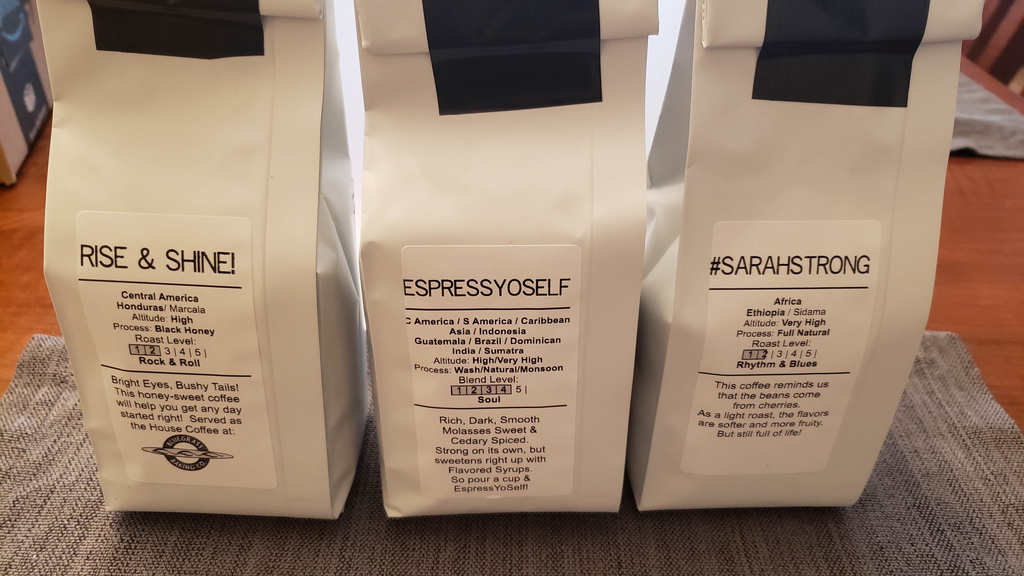As I continue my palate-developing tour of Lexington, KY's local roasters, three selections from GarageBean'd. I've tasted them as 16:32 ~30s espresso and as 11:200 Hoffman-method Aeropress, fresh ground appropriately for each.
They're super reasonably priced ($10-15/lb) for single-origin small-roaster products, and do bags from 8oz-1lb (and samplers) so you can try stuff, both of which are things I appreciate.
All three I picked are extremely characterful, and at least pretty good. I intentionally picked stuff that would be interesting for palate development rather than specifically to my tastes. I've done the reading for other-than-washed process coffees, but not tried many, and that was a lot of the focus for this round.
EspressYoSelf is a fairly classic modern espresso blend, the bill lists components from Brazil, Guatemala, Dominican Republic, Ethiopia, & India. It also notes a mix of Washed, Dry, Natural and Monsooned components. They roast it barely into medium-dark, just over 5/10 on their scale, which is around my preference for Espresso. It's SUPER complex with lots of molasses and spice notes. It does have a slightly "dirty" finish compared to some other espresso blends from my local tour; I'm not a good enough taster to pick out for sure why, I think it might be the monsooned probably-Indian-robusta component. The body kind of reminds me of stabilized whipped cream: it starts out feeling really substantial and kind of thins in your mouth, which is nifty. Good. Not enough to displace Nates from my #1 spot for local espresso blends, but definitely worth having.
#sarahstrong "Light" (they sell it at two roast levels) is a Natural process from Sidama, Ethopia, roasted light, 1.5/10 on their scale. It's super interesting, but a little funkier than I'm generally in to. Not bad, the body and fruityness are excellent... but there's a lot of that "rotten fruit" kind of fermented flavor that naturals are known to pick up, and it's a little much for me as an everyday coffee. Definitely a fun pick if you want to try a face full of natural process character.
Rise & Shine! is a Black-Honey process from Marcala, Honduras roasted to Medium (4.5/10). It would be high-character coffee in any other company, but it comes off as the most normal here. It's naturally quite sweet up front, with a very prominent dark honey/brown sugar kind of flavor, a bitter note in the middle, and a very clean, classic "nice cup of coffee" finish. It's the house coffee at a local bakery and really suits the role - it always feels like something I should be drinking out of china with a fancy pastry.

I've definitely had (good) blends were the components were taken to significantly different roast levels.
AFIK generally the components in blends are roasted separately for added control. Different beans behave differently in roasting so coffee that is blended then roasted will generally not be consistent anyway.
The separation lets a roaster take components to different levels to compliment each, eg. Roast a component with really good body but harsh flavor relatively dark to reduce the perceived bitterness, or keep a component you're adding for fruity flavors or acidity light so you don't suppress it's desirable properties.
The former (harsh but big-bodied) thing is a common trick for Espresso in particular, a lot of really big-bodied beans tend to taste harsh, and that can be reduced with darker roasts without killing thr body. Robusta/Canephora (rather than Arabica) beans especially tend to be big bodied and highly caffeinated and hardy to grow...and have a major burning rubber note to their flavor. Good espresso blends often add some to improve mouth feel...but also cheap coffee products tend to use it, most instant or coffee flavoring starts as Robusta.
Single origin doesn't automatically mean good coffee, but roasters who bother to source and label a single origin (which can sometimes be as specific as a farm, or broad as a country) will tend to be more mindful of that particular beans' flavor. Also, smaller fancier roasters will generally sell fresher coffee. Beans that have been sitting roasted in a grocery chain's "nonperishable" supply chain for months will essentially always be stale, and as soon as you get a taste for coffees that aren't, you are cursed with that knowledge.
Single origins (and "weird" drying processes other than fully washed) will also tend to have way more character than "just coffee" which is fun and interesting but not always desirable. You can build really delicious (and consistent) coffee with blends in ways that might not be achieveable with a single bean.
I appreciate the thought-out response! That makes a ton of sense that they would want to roast beans differently for better control. Also makes sense that they would want to blend the strengths of the different beans. I brewed my first gesha this morning and was floored by how tea-like it actually was. In the face of such an extreme, I could see the desire to pull pieces from that and perhaps blend with a natural process bean. Interesting shit.
Thanks again for the rundown, mate. It's super helpful to understand this stuff as I work to expand my pallet; it helps me figure out what I'm looking at and what I want to target next.